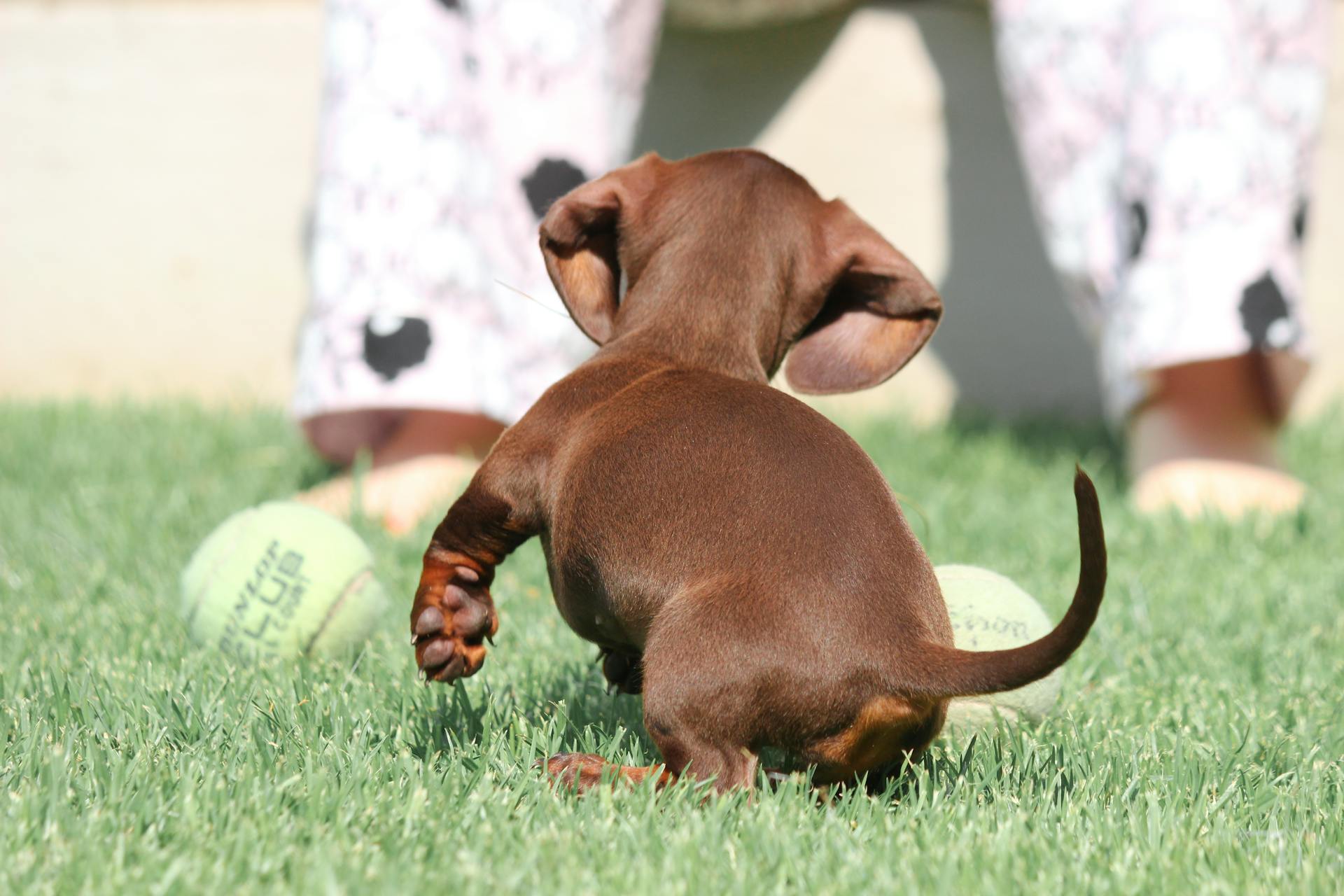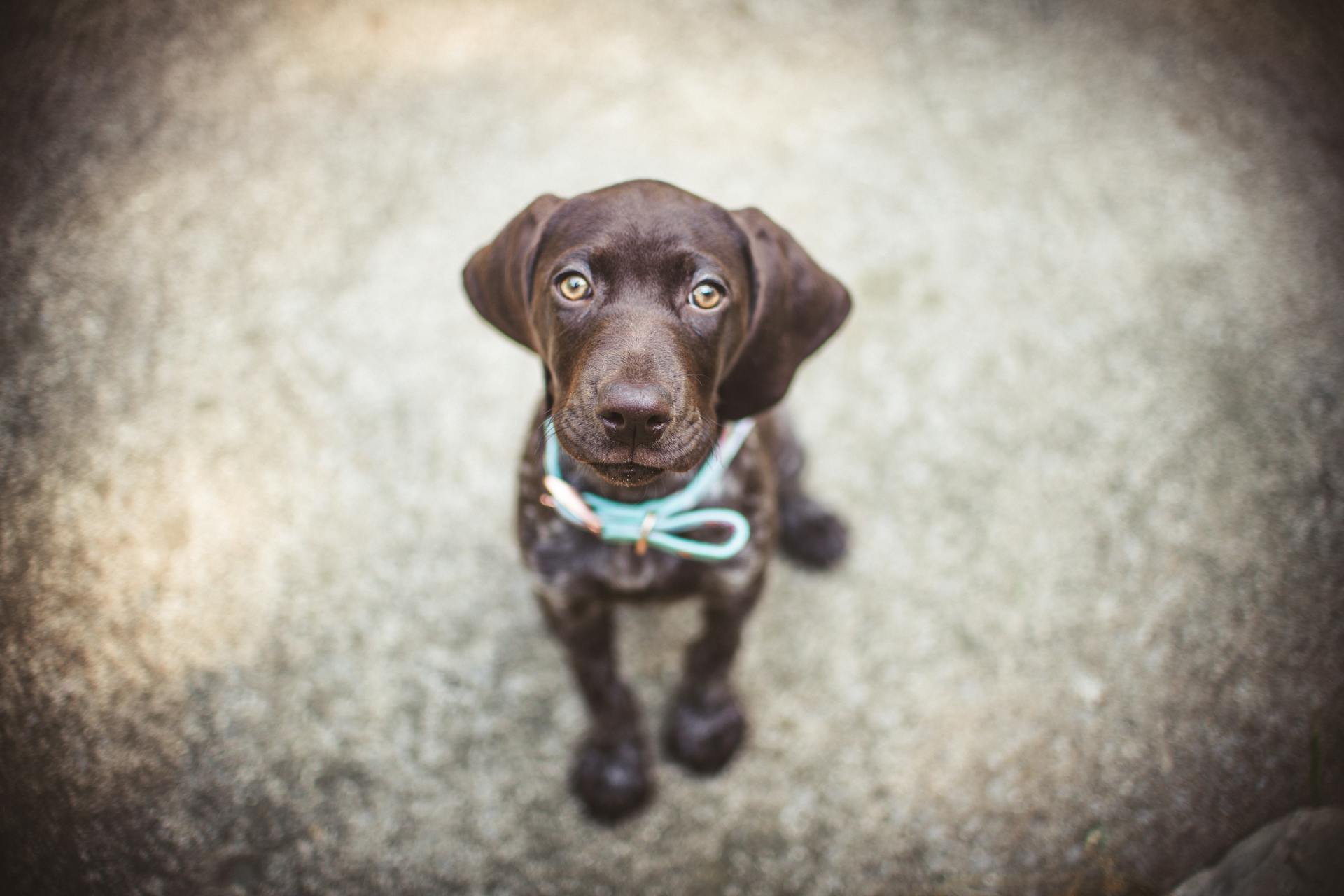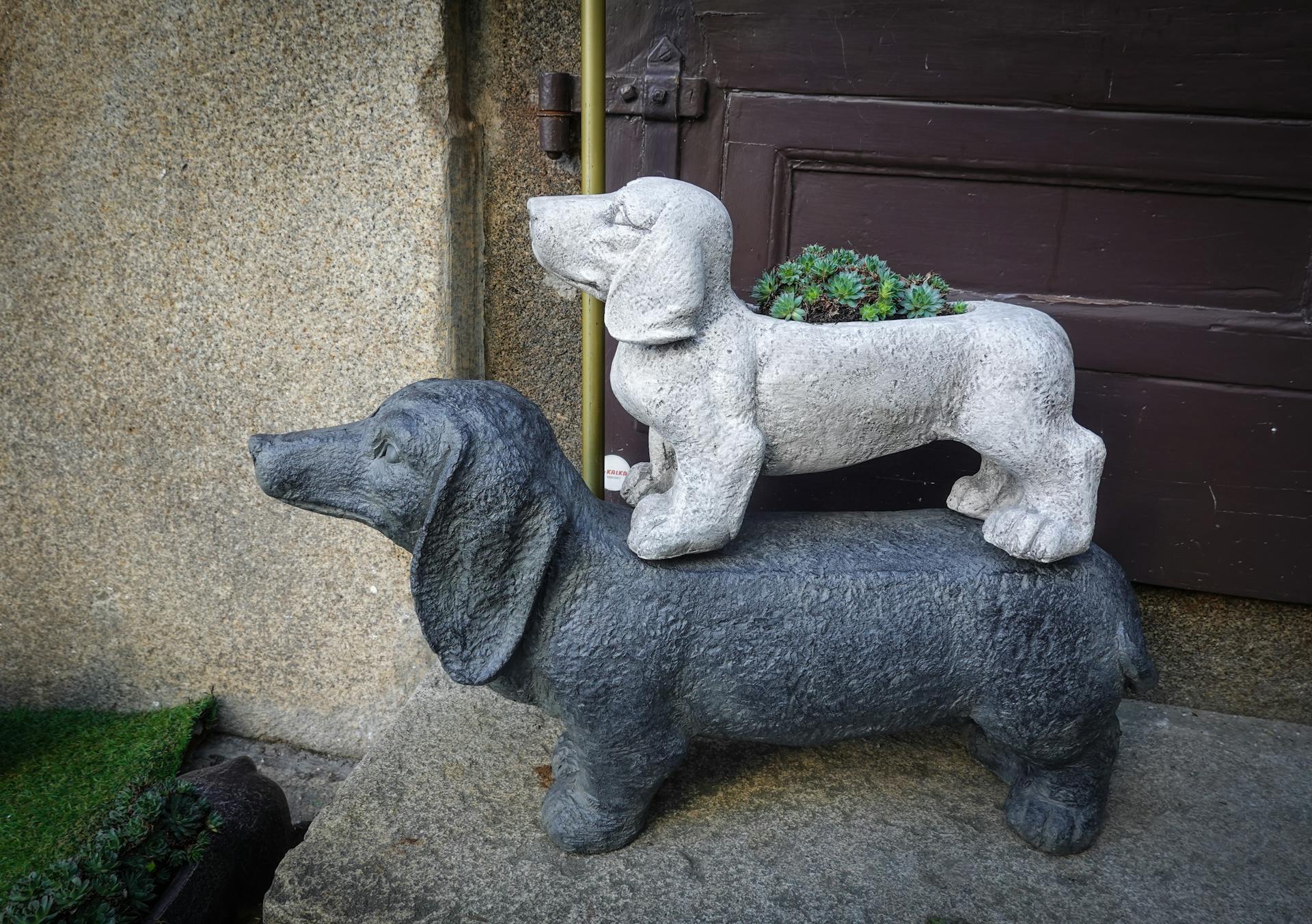
The Double Dapple Dachshund is a unique and captivating breed.
They are known for their distinctive coat pattern, which features a mix of black and red dapples on a cream or red base.
Their short stature and long bodies make them a recognizable and adorable sight.
Double Dapple Dachshunds typically weigh between 16 and 32 pounds, with males being slightly larger than females.
Their lifespan is generally between 12 and 16 years, making them a long-term companion.
For more insights, see: Are Long Haired Dachshunds Double Coated
Genetics and Health
Double dapple dachshunds are at a heightened risk of vision impairment or blindness, hearing impairment, or even complete deafness due to the same gene responsible for their coat pattern.
This is not uncommon, as many double dapples are both blind and deaf. Their lack of pigment also makes them more sensitive to sun exposure, increasing the risk of skin damage and skin cancer.
The Dachshund breed already suffers from some concerning genetic health issues such as intervertebral disk disease, hip and elbow dysplasia, patellar luxation, and more.
Curious to learn more? Check out: Skin Disorders Dachshunds
Some of the specific health issues double dapple Dachshunds are prone to include obesity, patellar luxation, Cushing's syndrome, allergies, progressive retinal atrophy, seizures and epilepsy, autoimmune issues, mast cell tumors, cataracts, and squamous cell carcinoma.
Here is a list of some of the health concerns associated with the double dapple Dachshund:
- Obesity
- Patellar luxation
- Cushing’s syndrome
- Allergies
- Progressive retinal atrophy
- Seizures and Epilepsy
- Autoimmune issues
- Mast cell tumors
- Cataracts
- Squamous Cell Carcinoma
- Blindness
- Deafness
The Dachshund's genetic makeup is also responsible for their short legs and unique body shape, a condition known as chondrodysplasia or canine dwarfism.
Characteristics
Dachshunds have a unique characteristic that sets them apart from other breeds - their ability to scent, chase, and flush out burrow-dwelling animals.
Their short stature and long bodies allow them to fit into tight spaces and navigate complex underground tunnels with ease.
In medieval times, there are paintings and references to badger dogs, but it's unclear if this specifically refers to the Dachshund breed.
Dachshunds have a distinct history that dates back to their original purpose as hunting dogs, where they would chase and flush out animals from their underground dens.
Genetic Health Issues
Breeding two dapple dachshunds can lead to severe genetic health issues, just like breeding two merles.
The Dachshund breed already suffers from genetic health issues such as intervertebral disk disease, hip and elbow dysplasia, patellar luxation, and more.
Double dapples are at a heightened risk of vision impairment or blindness, hearing impairment, or even complete deafness.
In fact, it's not uncommon for double dapples to be both blind and deaf.
Their lack of pigment makes them more sensitive to sun exposure, increasing the risk of skin damage and skin cancer.
Here are some of the health issues associated with the dapple pattern:
- Obesity
- Patellar luxation
- Cushing’s syndrome
- Allergies
- Progressive retinal atrophy
- Seizures and Epilepsy
- Autoimmune issues
- Mast cell tumors
- Cataracts
- Squamous Cell Carcinoma
- Blindness
- Deafness
Form of Dwarfism
Dachshunds have a form of dwarfism, which is caused by a gene called chondrodysplasia. This gene is also responsible for the short legs and unique body shape of many other long-bodied, short-legged breeds like Corgis, Basset Hounds, and Beagles.
The gene occurs naturally in these breeds and is associated with genetic health conditions like intervertebral disc disease. This is because the abnormal development of cartilage, known as chondrodystrophy, causes the long bones of the body to grow at an abnormally slow rate, resulting in shortened legs.
Chondrodysplasia is a natural part of the genetic makeup of these breeds, but it can also lead to other health issues.
For another approach, see: Dapple Dachshund Health Problems
Not a Color
Dapple is not a color, but rather a coat pattern seen on dachshunds. It's a unique spotting that can occur in various color combinations.
The most common dapple color combination is a blue coat with gray, black, brown, or tan. This pattern can result in puppies with striking appearances.
Double dapples have blue eyes and often exhibit a lot of white in their coat. Some double dapples can even be predominantly white.
The probability of puppies receiving the double dapple gene when two dapples are bred is approximately 25%. This is an important consideration for dachshund breeders.
Take a look at this: Blue Dapple Piebald Dachshund
Unique Coat Patterns
Dapple is a unique coat pattern found in Dachshunds, characterized by spotting on their coat. It's not a color, but rather a pattern that can occur in various colors.
The most common dapple colors are a combination of blue with gray, black, brown, and tan. This pattern can result in a predominantly white coat with blue eyes.
Consider reading: Blue Dapple Dachshund
Double dapples have a higher probability of receiving the double dapple gene when two dapples are bred, approximately 25%. This is because they inherit two copies of the dapple gene.
The dapple pattern can be combined with various colors and patterns, including brindle and piebald. The official standard for the breed allows any color to come with a dappled pattern.
Here are some of the most common dapple colorings:
- Chocolate and tan
- Chocolate
- Silver dapple
- Red dapple
- Black and tan brindle
- Blue and tan piebald
- Black and tan
- Black and cream
- Blue and cream
- Wild boar
Popularity and Recognition
The Double Dapple Dachshund's popularity has been on the rise for decades. They've consistently ranked among the top 20 most popular dog breeds in America.
Their popularity began to soar in the 1930s and 1940s, after being introduced to the United States in the late 1800s. This surge in popularity was a significant change from their original purpose as hunting dogs.
The Gained Popularity
The Double Dapple Dachshund's popularity can be attributed to its adaptable nature and versatility. They were bred for badger hunting, but their role changed over time, making them a popular companion breed.

Their size has decreased significantly since their original breeding, with modern-day full-sized dachshunds being much smaller than their ancestors. They now come in two size varieties: standard and miniature.
The breed's popularity soared in the 1930s and 1940s, and they have consistently remained a popular breed since then. They currently rank among the top 20 most popular dog breeds in America.
Their adaptability and friendly nature have made them a favorite among many dog owners, and their popularity shows no signs of slowing down.
For another approach, see: Different Sizes of Dachshunds
Formal Recognition
The American Kennel Club recognized the Dachshund in 1885, just after the breed arrived in the United States. This marked the beginning of formal recognition for the breed.
The Dachshund is now recognized in two variations and three coat types. Most European countries, however, have concerns about the associated health risks.
The Kennel Club of the United Kingdom stopped accepting the registration of Dachshunds resulting from two dapple pairings as of January 10, 2010.
Is a Good Pet?
Double dapple dachshunds can make great pets, but they do require a lot of attention and exercise, needing about an hour of mild exercise per day.
They have a high prey drive, which means they love to chase animals and toys, and they're also very vocal, barking a lot.
Their hunting heritage also makes them prone to aggression with strangers and other dogs, and they may not be the best fit for households with small pets.
However, they are fiercely loyal to their owners and make great companions, thriving on attention and interaction.
They can be stubborn, especially with potty training, which requires patience and consistency.
Double dapple dachshunds are generally playful, clever, and lively, but they do need regular grooming, depending on their coat type.
With the right care and attention, they can make wonderful pets for the right owner.
See what others are reading: Do Dachshunds Bark a Lot
Frequently Asked Questions
How do you tell the difference between a piebald and a double dapple Dachshund?
To identify a piebald Dachshund, look for a predominantly white coat with patches of color, whereas double dapples have distinctive dapple markings on their entire body. The presence of the piebald gene can be confirmed by checking the parents' coat patterns.
How to tell if your dog is a double dapple?
Identify a Double Dapple by large, asymmetrical white patches on your dog's body. Unlike Piebalds, Double Dapples have distinctive markings, not just random white areas
How long do double dapple Dachshunds live?
Double dapple Dachshunds typically live for 10-14 years, as the double dapple gene can affect their lifespan and overall health. Their shorter lifespan is a concern among breed specialists.
Featured Images: pexels.com

